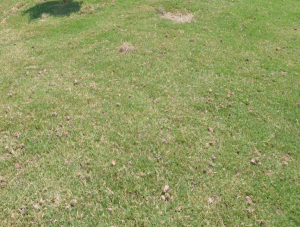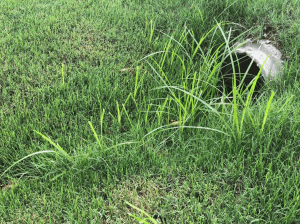Now is the Time For Warm Season Core Aeration Core aeration removes a small plug of thatch and soil and should be completed annually on Warm Season Turf (Bermuda, Zoysia and Centipede). Core aeration is significantly important if your lawn received winter injury this year. It should be completed annually from June to August. Core… Read more »

Core aeration removes a small plug of thatch and soil and should be completed annually on Warm Season Turf (Bermuda, Zoysia and Centipede). Core aeration is significantly important if your lawn received winter injury this year. It should be completed annually from June to August.
Core Aeration Will:

Yellow Nutsedge is a prolific and very difficult weed to control in many lawns and natural areas. Nutsedge is not a broadleaf weed or grassy weed but is in the sedge family. Yellow Nutsedge is a summer perennial that flourishes from April/May to around September/October. It reproduces from tubers (nutlets) under the soil and can spread from rhizomes. Each plant can produce hundreds of tubers during its growing season. These new tubers will be new plants in the years to come. Nutsedge will have a triangle stem and is easily felt when you twirl a stem between your thumb and forefinger. Yellow Nutsedge will grow much faster than the existing turf and will have a thin shiny appearance.
Post-emergent broadleaf weed controls for weeds like clover and dandelions will not control Nutsedge. There are limited products available for controlling Nutsedge and all of them require frequent applications over multiple years to offer acceptable control.
Proper mowing height is essential for proper turf health and performance. Here are the heights to keep your lawn healthy:
Fescue requires a mowing height of 3.5″ to 4.0″
Bermuda requires a mowing height between 0.5″ to 1.5″ at the highest
Zoysia performs best between .75″ to 2.5″ at the highest depending on the variety.
Centipede should be cut around 0.5″ to 1.5″
St. Augustine performs best 1.0″ to 2.5″
Summer is turf disease season for cool season grasses. Brown patch fungus started in early May this year. It is always better to control diseases preventively vs. curatively.
Brown Patch Fungus activates within a distinct set of climatic parameters. Brown Patch will activate when the temperatures are above 75 degrees with high atmospheric moisture. This moisture can be in the form of rainfall, irrigation or humidity.

Signs of Brown Patch will be an off color similar to drought stress, lesions on the leaf blade, browning of the turf in circles or areas. The easiest way to identify Brown Patch is to stand away from the lawn and look for a shadow appearance on the lawn. Once you identify the area of concern, look at the leaf blades of the plant for tan or brown lesions. If you see these lesions more than likely you have Brown Patch. Drought stress can be mistaken for Brown Patch. Drought stress will make the leaves fold at the center giving the leaf blade a straw appearance.
Unfortunately, fescue has little or no resistance to Brown Patch Fungus. Several seed companies are currently trying to increase their turf type fescue varieties to have resistance to Brown Patch Fungus. However, breeding programs take years to develop successful new varieties of turf type fescue.
There are a couple things you can do to help reduce Brown Patch activity. Avoid watering past 2:30 pm. This will give the plant time to dry before nightfall. Cut lawn on a regular basis and at the proper height for your type of turf. This will allow more air circulation across the leaf blade.
A fungicide can be applied that will arrest the fungus for approximately 25 to 28 days. If the fungicide is applied before damage is done to the leaf blade or plant, the fungicide will give the plant time to recover. Due to the high humidity level in this part of the country, Brown Patch can go active again after the fungicide has expired in about 25 days. Another application will be necessary to prevent damage to the plant from Brown Patch Fungus. Many people are utilizing our Preventative Fungicide Program to prevent major damage to their turf.
Some lawns are struggling to recover from the hot dry period we had last month. All turf types struggled last month even if they were irrigated. Warm and cool season turf went into a dormant/semi-dormant state for about three weeks. There are several factors that contribute to how well the lawn recovers after a period of hot dry weather.

Japanese beetles make their appearance this month. Japanese Beetles enjoy eating the leaves of many ornamental trees, shrubs and garden plants. Many have firsthand experience with the damage beetles can create to the desired plants. Roses, Crepe Myrtles and Cherry trees are some of the first in our area to see Japanese damage.
Safely enjoy the 0utdoors this Summer by controlling disease-ridden mosquitos at home. We all know Mosquitos transmit diseases like West Nile Virus, Encephalitis and Chikungunya. Now we have another one to worry about; Zika!
Fairway Green’s Mosquito Control program can help control Mosquitos giving you and your family peace of mind.
Receive $10.00 of your first application. *New customers only, cannot be combined w/other offers.